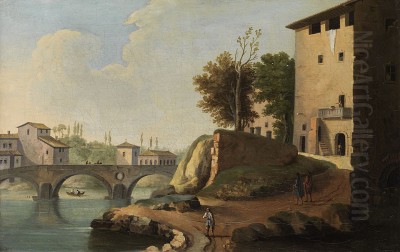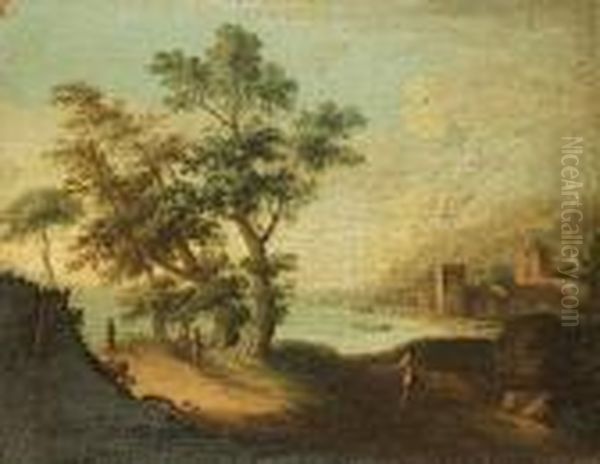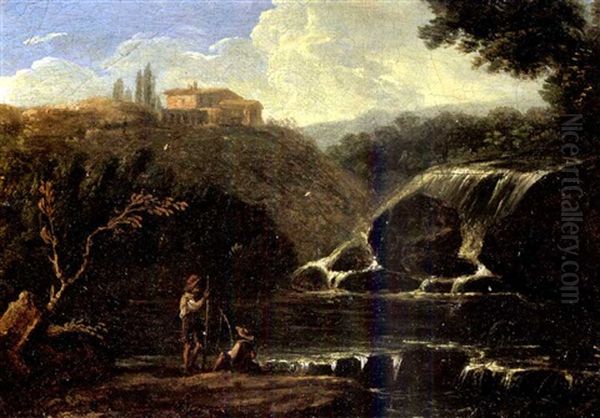
Paolo Anesi stands as a significant figure in the landscape painting tradition of 18th-century Rome. Born in the Eternal City in 1697, he dedicated his artistic life to capturing the serene beauty and historical resonance of the Roman countryside, known as the Campagna. Active during a period when Rome was a compulsory stop on the Grand Tour for Europe's elite, Anesi's work catered to a growing demand for evocative views of Italy's famed landscapes and ancient ruins. He was not only a painter but also a skilled etcher and printmaker, contributing significantly to the visual culture of his time before his death in 1773.
Roman Roots and Artistic Beginnings
Paolo Anesi entered the world in Rome on July 9, 1697. His father was a silk weaver who had come from Venice, suggesting a family background connected to craft and perhaps commerce, rather than established Roman aristocracy. This connection to Venice, a city with its own rich artistic traditions, particularly in color and light, might have subtly influenced the young Anesi's sensibilities, although his artistic identity would become firmly rooted in Rome.
Little is documented about his earliest years, but it is clear that he soon turned towards the arts. Rome in the late 17th and early 18th centuries was a vibrant artistic hub, still basking in the legacy of the High Baroque but also witnessing the emergence of new styles and sensibilities, including a burgeoning interest in landscape painting as an independent genre. It was within this stimulating environment that Anesi began his formal artistic training.
Formative Training and Influences
Anesi's artistic education involved studying under several notable masters, providing him with a solid foundation in the techniques and conventions of the time. Among his teachers were Giuseppe Bartolomeo Chiari, a prominent painter in the classical tradition favored by Carlo Maratta. From Chiari, Anesi likely honed his skills in figure drawing and composition, elements that often subtly populate his landscapes.

He also studied with Bernardino Fergioni, a painter known for his marine scenes and landscapes, often incorporating dramatic coastal views and atmospheric effects. Fergioni's influence might be seen in Anesi's handling of light and atmosphere, particularly in his depictions of water and sky. Another significant teacher was Sebastiano Conca, a highly successful painter from Naples who established a flourishing studio in Rome, known for his elegant, late Baroque and early Rococo style. Conca's emphasis on graceful composition and refined finish could also have left its mark on Anesi's approach.
Beyond his direct teachers, Anesi absorbed the artistic currents swirling around him. The legacy of 17th-century masters like Claude Lorrain, who had perfected the idealized classical landscape, provided a foundational model for all subsequent landscape painters in Rome. Anesi would build upon this tradition, infusing it with his own observations and the specific character of the 18th-century Roman school.
The Emergence of a Landscape Master: The Veduta
Anesi specialized in vedute, a term encompassing view paintings, particularly topographical scenes, landscapes, and cityscapes. While artists like Canaletto and Bernardo Bellotto in Venice focused on urban vedute, Anesi primarily dedicated himself to the veduta di campagna – views of the countryside surrounding Rome. The Roman Campagna, with its rolling hills, meandering rivers like the Tiber and Aniene, ancient aqueducts, crumbling tombs, and picturesque farmhouses, offered a wealth of motifs.
These landscapes were not merely topographical records; they were often imbued with a sense of nostalgia, Arcadian idealism, and the poignant beauty of decay. Anesi excelled at capturing the specific light and atmosphere of the region – the hazy warmth of a summer afternoon, the cool clarity of morning light, the gentle transition of tones in the distance. His work resonated with the sensibilities of Grand Tourists seeking souvenirs that captured the essence of the Italian landscape, steeped in history and natural beauty.
Anesi's Distinctive Style
Paolo Anesi developed a recognizable and appealing style characterized by delicate brushwork, a soft, often luminous palette, and a tranquil, contemplative mood. His compositions are typically well-balanced, often employing framing devices like trees or architectural elements to lead the viewer's eye into the scene. Unlike some contemporaries who might favor more dramatic or turbulent landscapes, Anesi's views generally exude a sense of peace and harmony.
His handling of foliage is often detailed yet feathery, and his rendering of water is typically calm and reflective. Figures, when included, are usually small-scale pastoral inhabitants – shepherds with their flocks, peasants resting, or travelers – serving to animate the scene and provide a sense of scale rather than dominating the composition. They contribute to the overall idyllic atmosphere, suggesting a timeless, harmonious relationship between humanity and nature.

The influence of Giovanni Paolo Panini (or Pannini), a leading painter of Roman views and capricci (architectural fantasies), is evident, particularly in Anesi's occasional inclusion of classical ruins. While Panini often focused on grand architectural ensembles and bustling scenes, Anesi adapted the motif of ruins into his more intimate landscape settings, integrating them naturally into the countryside vistas. There might also be echoes of the atmospheric sensitivity found in the works of Venetian painters like Francesco Guardi, perhaps reflecting his father's origins or the general artistic exchange between Italian centers.
Key Themes and Subjects
Anesi's oeuvre revolves around the landscapes near Rome. Common subjects include views along the Tiber River, scenes featuring the waterfalls and temples at Tivoli, depictions of ancient bridges like the Ponte Molle (Pons Milvius), and generalized pastoral scenes incorporating characteristic elements of the Campagna. He often painted pairs or series of landscapes, intended to be displayed together, offering contrasting or complementary views.
Ruins feature prominently but are usually integrated harmoniously within the natural setting, suggesting the gentle passage of time rather than dramatic desolation. These might include fragments of ancient tombs, sections of aqueducts, or unidentified classical structures, lending a historical dimension to the pastoral scenes. His focus remained steadfastly on the interplay of light, land, water, and sky, creating evocative snapshots of the Roman environment.
The Art of Etching
Beyond his work in oil paint, Paolo Anesi was also an accomplished etcher. Printmaking was an important medium in the 18th century, allowing artists to reproduce their compositions and reach a wider audience. Anesi's etchings often mirrored the subjects of his paintings – landscapes, ruins, and pastoral scenes.
His work in this medium demonstrates a fine control of line and tone, effectively translating the atmospheric qualities of his paintings into black and white. These prints would have been more affordable than paintings and played a crucial role in disseminating his artistic vision and contributing to the popular imagery of the Roman Campagna among collectors both in Italy and abroad, particularly in England and France where Grand Tour souvenirs were highly sought after.
A Network of Artists: Rome in the 18th Century
The art world of 18th-century Rome was a complex ecosystem of native Italian artists and foreign painters drawn to the city's classical heritage and artistic opportunities. Anesi operated within this vibrant community, interacting with numerous contemporaries. Besides his teachers Chiari, Fergioni, and Conca, and the influential Panini, the scene included figures like Pompeo Batoni, the leading portrait painter in Rome, whose clientele largely consisted of visiting Grand Tourists.
Landscape painting itself was a thriving genre. Gaspar van Wittel, known as Vanvitelli, though slightly earlier, had laid much groundwork for topographical vedute in Rome. Jan Frans van Bloemen, nicknamed 'Orizzonte', was another highly successful Flemish painter specializing in idealized classical landscapes in the tradition of Claude Lorrain and Gaspard Dughet. Hubert Robert, a French artist, spent considerable time in Rome painting romanticized views of ruins, overlapping with Anesi's period. Anesi's career unfolded amidst this rich tapestry of talent and stylistic exchange.
Collaboration with Andrea Locatelli
One of Anesi's notable connections was with Andrea Locatelli (1695-1741), another highly regarded landscape painter active in Rome. Sources suggest they may have collaborated, particularly in Locatelli's earlier years, possibly even sharing some aspect of their training or early studio practice before 1712. Both artists shared an interest in depicting the Roman Campagna, though Locatelli often incorporated mythological or biblical figures more prominently into his scenes.
The exact nature and extent of their collaboration remain somewhat unclear, lacking documentation of specific jointly produced works. However, their careers ran parallel for a significant period, and they were considered among the leading landscape specialists of their generation in Rome. It's plausible that Anesi's established style influenced the younger Locatelli initially, as suggested by some art historical accounts. They were certainly key figures within the same artistic niche.
Working with Paolo Monaldi and Alessio Demarchis
Anesi is also documented as having worked alongside other contemporaries, including Paolo Monaldi (c. 1710–after 1779) and Alessio De Marchis (1684–1752). Monaldi specialized in genre scenes, often depicting peasant life, festivities, and rustic interiors with lively figures. De Marchis was known for landscapes and architectural views, sometimes featuring dramatic elements like fires or storms.
Collaboration often involved specialists combining their skills; for instance, a landscape painter like Anesi might create the setting, while a figure painter like Monaldi would add the staffage. One specific work mentioned in auction records, "LANDSCAPE MIT ZIEGEN UND RINNSALEN" (Landscape with Goats and Rivulets), measuring 60.5 x 118 cm, has been attributed to the collaboration of Anesi, Monaldi, and De Marchis. While the reported date of 1697 for this work seems impossible given Anesi's birth year, the attribution points to documented instances of these artists working together, pooling their respective talents to create composite works appealing to the market.
Recognition and Esteem: Academy Membership
Anesi's talent and growing reputation earned him recognition within Rome's official art institutions. He became a member of the prestigious Accademia di San Luca, the city's primary academy of arts. Membership was a significant honor, signifying peer recognition and placing him within the established hierarchy of Roman artists. The Academy served as an educational institution, a professional association, and a venue for exhibitions, and Anesi's inclusion reflects his standing in the artistic community.
The Virtuosi al Pantheon
Further evidence of his professional integration comes from his membership in the Congregazione dei Virtuosi al Pantheon (Congregation of the Virtuosi at the Pantheon). Founded much earlier, this confraternity was composed of distinguished artists, architects, and musicians who met at the Pantheon. Membership was another mark of distinction, connecting Anesi with other leading creative figures in Rome and participating in the city's cultural and religious life. Some sources even mention him potentially fulfilling minor clerical roles or participating in ceremonies, indicating a respected position within the community beyond his painting activities.
Patronage and Collections
Anesi's appealing landscapes found favor with patrons, including members of the nobility and potentially figures connected to the Papal court. His works were acquired by discerning collectors, both Italian and foreign. The popularity of the Grand Tour meant that many British and French visitors sought out high-quality view paintings as mementos of their travels, and Anesi's works fit this demand perfectly.
His paintings entered important collections during his lifetime and afterwards. Today, his works can be found in major museums, including the Capitoline Museums in Rome and the renowned Uffizi Gallery in Florence, which holds works within its collection of artists' self-portraits and representative pieces. Numerous other paintings reside in private collections across Europe and North America, testament to his enduring appeal.
Representative Works
While a comprehensive catalogue raisonné might be complex due to workshop practices and attribution challenges common in the period, several works exemplify Anesi's style. "Paesaggio con armenti e greggi" (Landscape: Cattle and Sheep), measuring approximately 60.5 x 118.5 cm, showcases his skill in depicting pastoral scenes with gentle light and carefully rendered animals within an expansive landscape.
Another example, often titled simply "Roman Countryside Landscape" or similar variations (like one measuring 32 x 50 cm), typically features the characteristic elements of his work: rolling terrain, distant hills rendered in soft blues, perhaps a winding river or a rustic building, all bathed in his signature atmospheric light. The title "Copia di paesaggi" (Copy of landscapes) found associated with some works might refer to workshop versions, replicas made due to demand, or perhaps studies, highlighting the practicalities of artistic production at the time.
Anesi's Influence: Francesco Zuccarelli
The quality and appeal of Anesi's work influenced subsequent generations of landscape painters. One notable artist who seems to have drawn inspiration from Anesi is Francesco Zuccarelli (1702-1788). Although primarily associated with Venice and later highly successful in England, Zuccarelli spent time in Rome early in his career. It is believed that he studied the works of Roman landscape painters, including Anesi. Zuccarelli's idyllic and decorative landscapes, often featuring charming pastoral figures and a light, airy palette, show a kinship with the Rococo grace found in some of Anesi's more gentle compositions, suggesting Anesi contributed to the broader development of the popular Arcadian landscape style in the 18th century.
Later Years and Legacy
Paolo Anesi continued to paint throughout the mid-18th century, remaining a respected figure in the Roman art scene until his death in 1773. He lived to witness shifts in artistic taste, as Neoclassicism began to gain momentum, but his work remained rooted in the picturesque landscape tradition that had brought him success.
He also passed on an artistic inclination to his family. His son, Luigi Anesi, is recorded as an artist, though perhaps less famous than his father. Luigi is noted for having painted religious works, such as decorations for baptistery ceremonies, indicating the continuation of artistic activity within the Anesi family, albeit potentially in different genres.
An Enduring Vision of the Campagna
Paolo Anesi carved a distinct niche for himself within the bustling art world of 18th-century Rome. As a master of the veduta di campagna, he captured the unique beauty and tranquil atmosphere of the Roman landscape with sensitivity and skill. His delicate brushwork, luminous palette, and serene compositions offered an idealized yet recognizable vision of the Italian countryside that resonated deeply with the tastes of his time, particularly among Grand Tourists.
Through his paintings and etchings, and his interactions and collaborations with contemporaries like Locatelli, Monaldi, and Panini, Anesi contributed significantly to the Roman school of landscape painting. His membership in prestigious institutions like the Accademia di San Luca confirmed his standing. While perhaps not as revolutionary as some figures in art history, Paolo Anesi remains an important artist whose work provides a beautiful and enduring window onto the landscapes and artistic sensibilities of 18th-century Italy. His paintings continue to charm viewers with their peaceful elegance and evocative portrayal of the timeless Roman Campagna.